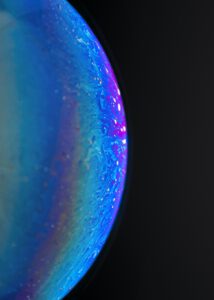
Dissonance Effect | People believe what they want to believe
Dissonance Effect | People believe what they want to believe „People believe, what they want
To publicly display one´s idea for others to critique and judge, one needs to be brave. A creative idea can be perceived as not creative at all or it is so creative and ahead of its time that people don’t get the idea. Either way, being creative means taking risks.
Creativity is the one thing that enables innovation and expression. Without creativity, there would be no house, no train, no car, no mobile phone. All those ideas are products of their time. Every idea is based on what we absorb. The mobile phone could not have been invented hundred years earlier than it was, as well as the car. Those ideas are based on earlier ideas that somebody had. Everything and every big idea is part of evolution and innovation. A part of something bigger that grows with time. So creativity is unbelievably important for humanity as a whole. We can be sure that creativity is the only thing that can save humanity in the future. The climate crisis is maybe a necessary problem for society, for someone to generate a new idea that is a step forward for humanity. And you may be one of the people who contribute to that solution. Even the smallest and simplest-seeming idea can ignite a chain of ideas that lead towards a big one.
Kids are the most creative members of society, yet the same grown children would not claim themselves to be creative in their adulthood. Why is that? Because we are taught that way. The educational system is not made for people to be creative, it is made for people to focus and repeat what others have done and to then compete who memorised best. Because creativity is not measurable, we learn that creative jobs are those of low income and assigned to avoid them. We are taught that creativity is nothing we should harvest but slowly forget about. So why is it that every kid is creative and not every adult? Adults do not play. They are stuck in their expertise. They learn to do things after certain rules that were set upon them by society. Society detaches us from playfulness and tells us to take life seriously, yet playfulness is what keeps us creative. Maybe the question is how to keep your inner child alive rather than growing up and losing it.
By reframing a challenge, we can quickly escape the prison of expertise. Expertise is crucial and allows us to make quick, smart and well-informed decisions but it is also the biggest barrier to creativity. To be creative, we need to think outside the norm/the box and this is the exact opposite of expertise. Words, like job titles, are attached to all kinds of assumptions/preconceptions. Just by renaming and reframing the title, the assumptions are gone. This creative playfulness opens a playground full of new possibilities and opportunities. A writer is no longer a writer but an adventure guide. A secretary is no longer a secretary but the director of first impressions. A filmmaker is no longer a filmmaker but a collector of time and space. This opens up the possibilities about what could be done. Next time when you are tasked with an assignment, reframing the nature of the assignment is maybe just what it needs to think outside the box.
Have you heard about the idea that creative people are more right-brain thinkers and analytical people are more left-brain thinkers? Sorry to disappoint you, but this is simply not true. Creativity does not happen in a particular hemisphere and part of your brain. Creativity happens because of many different brain networks that are responsible for different tasks. Creative ideas are formed of strategies, personal preferences, experiences, emotions, feelings and everything there is. Ideas that we create are a mixture of what goes on inside of our heads. Has it ever happened to you, that a group of creative people is faced with a creative challenge and everybody somehow had the same result? At least this has happened to a few tasks within our classes at the WdKA. It was maybe because we all were basically on the same level of developing our creative ability. Possibly we are all more similar than we like to think. It is an interesting phenomenon that even if the individual thinks that they are original, everybody thought about the same. Maybe the answer lies within the four c model of creativity. Most likely there is no one solution but maybe we can conclude that we sometimes have to search and think more in-depth to come up with something that truly originates from us.
Ask: What if?
That is maybe the most powerful question to ask. Do not take things how they are but play with them, play with reality and your ideas. The longer we play the more extraordinary the idea gets. What if the poster could speak? What if the poster could interact with the viewer? What if the book could read itself? This question challenges you to think beyond. Looping ideas is also a great phenomenon and a technique one can harvest and use. Bouncing ideas between different persons can alter them in a way that makes them more captivating. This may also be just called brainstorming with multiple people. But perhaps this concept can be dragged into more extreme and intense sessions. But how does creativity work? We, as future professional creatives should be able to answer this question in order for us to perform and maybe save humanity one day.
The answer lies in the thing between your eyes. The state of your mind in a particular moment. The alpha state of the brain is proven to be the state where the brain is the most creative and can absorb the most information. Unfortunately, this state requires us to be calm, peaceful, relaxed, happy and engaged. Very unfortunate for our school system I mean. Most of us were bored before even entering the classroom. This is the killer for alpha waves. In that moment of boredom and pressure to get a good grade to pass, we were in the beta state. Also in most work environments when we concentrate on a task we enter the Beta state. Beta waves are simply a frequency of active, busy and anxious thinking. This keeps us from being creative.
The Alpha waves have a frequency of 8-12 Hz. The Beta waves have a frequency of 12 to 38 Hz. To get into the Alpha state, we need to calm down. Yes, it’s that easy. Take a deep breath and focus on your body. The Alpha state is a state of meditation. So concentrate on the present. By doing that you lower your heartbeat, you will calm down, the frequencies are lowered and you enter the alpha state. Well done. Nonetheless, the beta state is a crucial state we sometimes need to be in to get work done. Try it! Does it work?
A kid that just drew something is creative. Albert Einstein as he developed the theory of relativity was creative. But there is a big difference. The ideas differ in originality, usefulness and future impact on their particular domain. Those are the main measurements for creativity. Based on those parameters, there are different models. This is where the theory of mini-c creativity to big-C creativity becomes interesting. Mini-c creativity describes learning and personal insights while big-C creativity describes the eminent, the extraordinary creativity. The more we move towards big-C creativity the fewer people in existence reach that stage. Your c creativity is domain-specific. You could be a big-c in playing the nose flute but a little-c in constructing houses out of popsicle sticks.
Mini-c creativity
Gaining new information that we did not know about or getting new insights are the most basic forms of creativity. Those new insights or information do not need to be new but just new and important to us. At this stage, it is about the individual. It does not matter if others would label insights, new information or actions as creative.
little-c creativity
This level of creativity is also called everyday creativity. At this stage, other people might label what you do as creative, like building your popsicle houses for example.
Pro-c creativity
This is dependent on you and others. Other experts in your domain need to declare or acknowledge you as an expert.
Big-c creativity
This stage is not as controllable as the pro-c stage. The ideas need to change the domain. We can take Albert Einstein as an example. At this stage, history decides whether your idea was and still is important or not. The creative individual who had the idea can no longer influence that. Where are you at? In which domain are you a little-c to pro-c creative?
So let’s go a step further. The model of the seven levels of creativity. Those can be connected with the four c creativity model. A different approach are the seven levels of the creative span. The Levels resemble stages from childhood to adulthood.
Level 1: Universal Creativity (in all people from infancy; also when learning something new)
Level 2: Rare compared to peers ( the child or adult creates unusual perspectives, actions, products, questions)
Level 3: Developing Talents (expertise acquisition of strategies and ways of doing things)
Level 5: Producing information (shift from adapting to a feel to beginning to add information to it)
Level 6: Creating by extending a field (linear trajectory)
Level 7: Transforming or Revolutionising a field (network trajectory)
The distinctions are based on six variables. The first variable is adaption. Initially, the individual adapts to the world and the work field. In stages four and five it turns. The world and the work field slowly starts adapting to the individual. The second variable is purpose. It is the shift from mastering the domain towards extending it to then transforming the domain. The third is novelty. This is the transition from something that is new to the individual to something that becomes rare and important to the peers. The next stage is when it becomes new to the world. Value describes the shift from valuable to the individual to valuable to the world. The next variable ‘speed’ describes the initial fast progress of the individual which gradually slows down. The last defined variable is mental structures, this is the incompletion through transformation. That means that mental incompletion and the curiosity to go further and further is a condition for transformation. We all like to believe that creativity has something magical to it. Maybe it does, maybe it doesn’t. I think the notion that creativity equals magic clarifies one thing: How important and powerful creativity is! In today’s world, we measure and seek to understand everything there is to understand. Measuring creativity and creating models is one step away from the mysterious force but one step towards better control over it. What is clear is that creativity, in the end, is the most important resource humans ever had and will ever have.

Dissonance Effect | People believe what they want to believe „People believe, what they want

Immersive CX by speaking to the senses When customers have a positive experience with a

How to write a marketing plan Write a marketing plan and prepare your start up.
Get notified about new articles.
I will not spam you, I promise.